A week long tour to the Scottish Highlands, with visits up to the Moray and Aberdeenshire coasts, as well as the chance to catch up with a few additional birds on the way up and on the way back. If you like the sound of what we got up to, we are already planning the dates to head up to Scotland again in 2024 – you would be very welcome to join us!
Sunday 19th March
Travel day. Three of the group met in Norfolk early in the afternoon, for a flat and uneventful journey out through the Fens and then up the A1/A1(M). After a quick stop for coffee at Wetherby, we went on to Darlington where we met up with the rest of the group. We had an early booking in a pub in town for dinner – it was Mother’s Day and had obviously been busy earlier in the day, but we now had the place to ourselves and a chance to discuss plans for the next couple of days. Then it was an early night, ahead of the onward journey tomorrow, when the fun would start.
Monday 20th March
Normally we would make a very early start and head up into the Pennines first thing, but with heavy rain forecast on the moors this morning, we had a change of plan. After a bit of a lie in, we met at 6.30am and drove over to Redcar, getting round Middlesborough before the traffic got too busy. It was cloudy but dry and fairly bright here, as we parked at the far end of the esplanade and got out to scan the sea.
There were a few small groups of Common Eider off this end of the beach, but not the eider we were looking for, as well as several Velvet Scoter and a single Red-throated Diver. Further off to the north, we could see a much larger group of Eider and looking through carefully we quickly picked out the 2nd winter drake King Eider which has been spending the winter here. It was very distant from here, and hard to see as even though there was only a light swell the waves were breaking on the rocks in front of the ducks, which all then swam into the breakers and started diving.
We walked back along to the other end of the esplanade. By the time we got there, most of the Eider flock had come out of the water onto the rocks. There was no sign of the King Eider with them initially, but then we realised it was in the pool just in front, feeding mostly with its head down. Walking out across the beach to the shore, it was much closer now and we had some great views. A very smart bird and a great one to start the trip with.
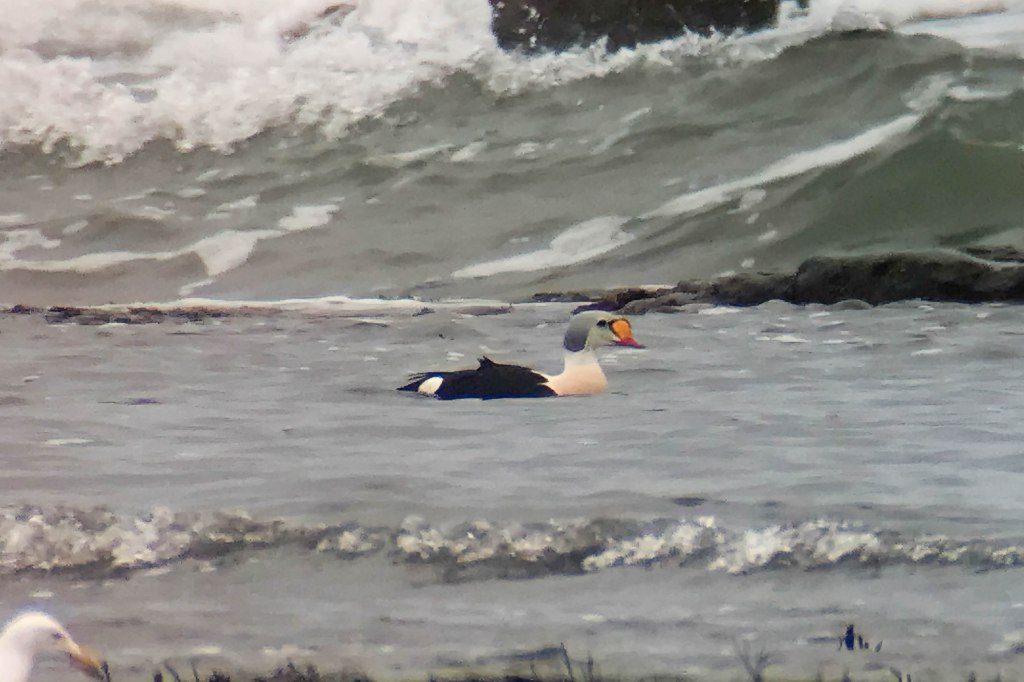
There were two or three Shag on the rocks too, and a female Long-tailed Duck appeared briefly in one of the pools which were forming between the reefs as the tide went out. A large flock of Common Scoter whirled round and landed on the sea, some distance off to the north across the bay. A selection of waders were on the rocks as well, including Oystercatchers, lots of Redshank, Turnstones and Sanderling. One or two of the latter two flew in and fed up and down on the edge of the sand in front of us.
It was time for breakfast and we had worked up a hunger with some early morning birding. There was nothing on the seafront open yet, so we drove round to Morrison’s and had a welcome hot drink and bite to eat in the cafe there, before resuming the journey north.
There had been an Alpine Swift at Bamburgh Castle on 17th and what could possibly be the same bird was reported again there this morning. It was only five miles off the A1, so we made a short diversion to see if we could catch up with it. Unfortunately there was no further sign of the swift, which had flown off inland before we arrived. We waited a while to see if it might come back, and we did see a Fulmar flying around the castle and a distant line of Whooper Swans heading north inland. Out to sea, we could see three Red-breasted Mergansers, a small group of Long-tailed Ducks with some smart drakes, another small party of Common Scoter and a couple of Razorbills out on the water and we picked up one or two Kittiwakes flying past. It was a lovely spot to stand and watch, down below the imposing castle, but we had a long journey ahead of us still, so we set off again on our way north.
It was cloudy but dry and bright in Northumberland, but the weather started to deteriorate as we got into Scotland. We stopped in Musselburgh to get some lunch, then drove down to the mouth of the Esk river and had a quick walk out to the edge of the sea. We were hoping to catch up with some more sea duck here, but it was drizzling now, and very misty out to sea. We could see lots of Goldeneye close in, but only about half a dozen Velvet Scoter were visible further out, along with a few Long-tailed Ducks. We did manage to find single of Red-necked Grebe and Slavonian Grebe, just visible on the edge of the mist when it lifted a little, and a lone Gannet resting on the sea in a line of gulls.
It was a slow drive then round Edinburgh and we carried on north through heavier rain on the final leg of the journey, up to Carrbridge, our base for the next few days. A nice hot cup of tea and biscuits were waiting for us on our arrival at the guest house and after settling in we enjoyed a delicious three course dinner.
Tuesday 21st March
We were all up early today for a short trip out before breakfast. We drove up onto the moors and parked on the edge of the road. The Black Grouse were already displaying on a small grassy hillside across the valley, nine males. Opening the windows, we could hear their bubbling calls. A lovely way to start the morning.
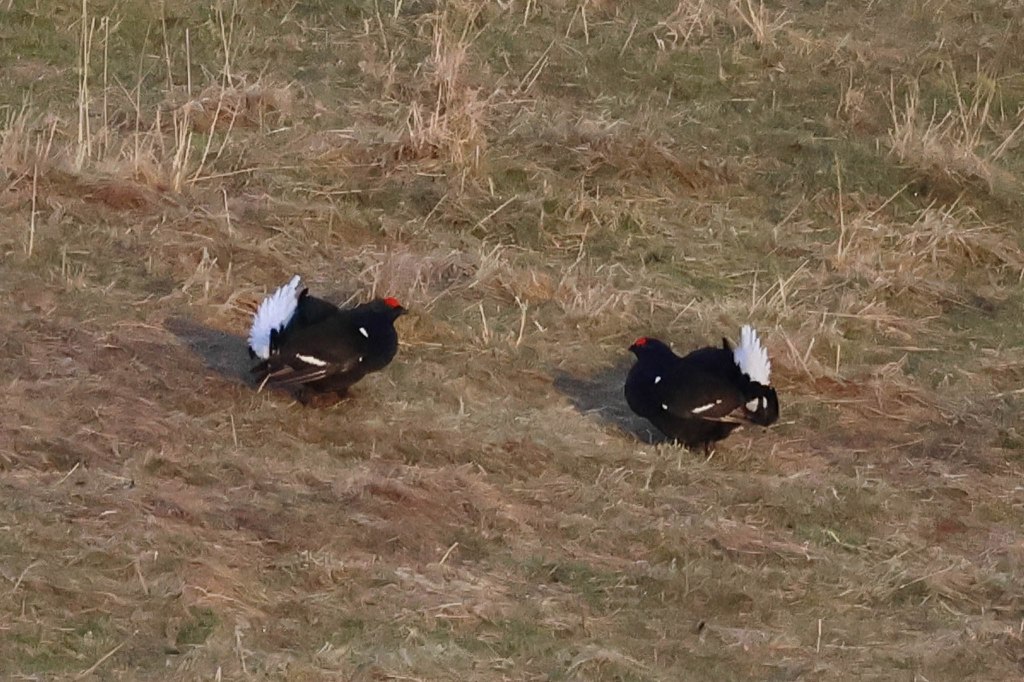
Several of the Black Grouse were facing off in pairs, occasionally having a go at each other, darting forward and lashing out with bill and legs, but no contact was made and the posturing continued. There was patchy cloud this morning, but as the sun started to rise it got high enough that it was shining on the lek and the Black Grouse looked very smart now in the sunshine. There were one or two Curlews displaying here too and a Raven flew over kronking. A couple of Roe Deer were feeding down in the valley.
We still had some time before breakfast, so we decided to drive over to Lochindorb for a quick look. Scanning from the road on the way down, we spotted three very distant Red Grouse on the edge of the loch. We got out and got the scope on one. We could hear Golden Plover calling, and two flew high overhead just as we got back into the minibus. Further round, we found another pair of Red Grouse very close to the road this time. We watched them from the minibus creeping through the heather, occasionally raising their heads, the male with bright coral-red eyebrows.
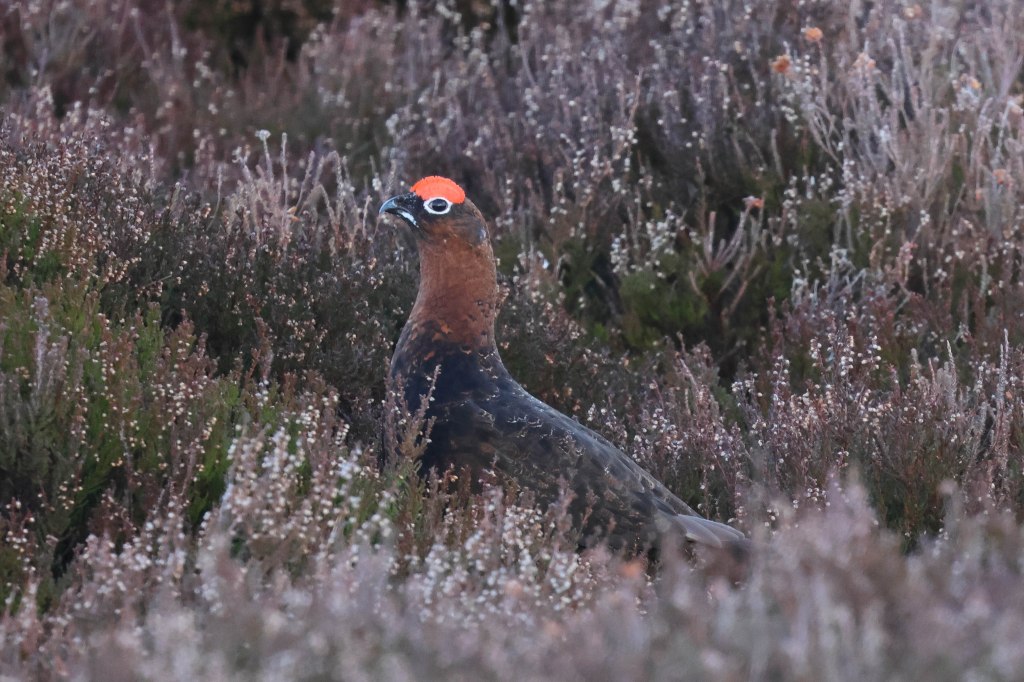
We had been told that no divers had returned yet to the loch, but we stopped for a quick scan anyway, just in case. All we could find were lots of Goldeneye. Then it was time to head back to the guest house for breakfast.
After breakfast we headed out again. After a quick stop to refuel in the filling station in the village, we slowed as we headed back over the bridge and stopped to look at the river. A Dipper was down below, in the water. It came out onto a rock and posed for us to get a good look, before it flew off downstream.
With the Scottish Capercaillie population in freefall, perilously low now, we do not go in to the woods at dawn – we do not go looking for them, as the risk of disturbance is too high. However, we do venture into the pines later in the morning, to look for other specialities of the Caledonian Forest. So we drove on now, down to the woods at Boat of Garten. We checked the feeders by the road first, but there were just one or two Chaffinches coming in. The pool opposite is quite dry this year, but a couple of Teal were new for the trip list, with the Wigeon and Mallard, and a Mistle Thrush was feeding on the ground nearby. As we walked back towards the car park, twelve Pink-footed Geese flew over calling, and circled over the fields the other side of the road.
Walking into the woods, there were plenty of tits in the trees at first, mainly Coal Tits, plus Great Tits and one or two Blue Tits. A Goldcrest was flitting around in a tree above us and a Mistle Thrush was singing from the tops somewhere. There were more Chaffinches, and a few Siskins flew back and forth overhead calling. We walked on down a bit further, but the further we got from the road and the feeders, the fewer birds there were.
There has been lots of logging recently here, and there was a lot of recreational disturbance this morning too, people with dogs barking and mountain bikers. It is one thing trying to restrict early access to the woods for birders to try to protect Capercaillie leks from disturbance, but there were no signs anywhere suggesting recreational users should also stay out in the early mornings. There still seems to be a distinct lack of joined up planning and advice here.
Moving on, we stopped at the Golf Club on the other side of the village. There were three people in the car park looking as we pulled up, but they hadn’t seen any sign of the Waxwing this morning. We got out and started scanning and there it was, in the top of a small birch tree over beyond the tennis courts. We had a quick look at it through the scope before it flew down to a small bush and started feeding on berries.
We walked round on the road and viewed through the fence from the staff car park at first. One of the greenkeepers walked past along the path only a couple of metres from the Waxwing and it didn’t move, so we asked permission to go in ourselves. We walked round to the path and had great views now, without the fence in the way. It gobbled down lots of berries quickly, then climbed up into the middle of the bush and stopped, preening and digesting.

The sky had cleared during the morning and it was nice and sunny now, with lots of patches of blue sky. It was warming up too, so we headed off to look for raptors. We drove up through one of the valleys and parked in a convenient gateway where we had a good view of the surrounding hills. When we got out, several Common Buzzards were circling up already. Perfect timing for a coffee break and a muffin while we scanned (we would not go hungry this week!).
A Kestrel appeared with the Buzzards, and then we noticed a Goshawk circling above. It started displaying, slow flapping high over the trees, before it eventually drifted off down the valley and we lost sight of it. A short while later, another Goshawk appeared, low in front of the hillside opposite this time. It disappeared behind some trees but then circled up higher shortly after and we had great views as it did so.
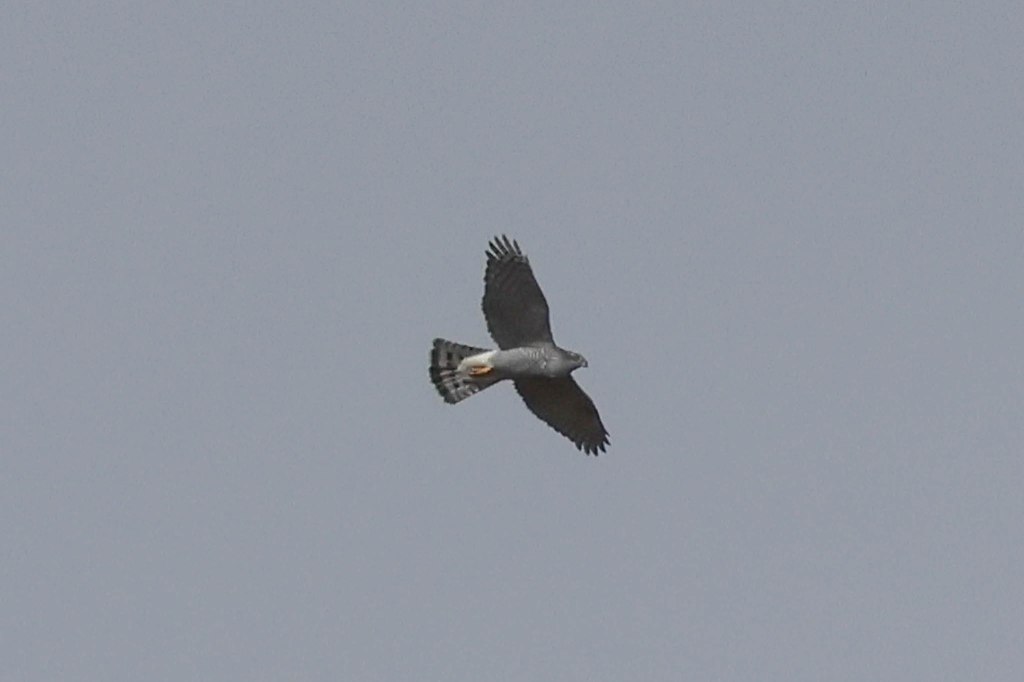
A Golden Eagle appeared high over the valley the other way now. It was dropping away from us all the time, and we eventually lost sight of it over the hills across the other side. After a while, one of the group spotted another Golden Eagle circling further up the valley. As we were trying to get it in the scope, we picked up a Peregrine flying over too! We got the scope on the Golden Eagle now, and it was joined first by a young White-tailed Eagle and then by another Golden Eagle, the three of them circling together for some time. It was great to see the shape difference between the two species side by side. Eventually, the two Golden Eagles broke off and drifted out over the valley. They were very high now, and we watched as they grappled talons a couple of times before breaking apart and disappearing off in different directions. What a great coffee break!
The RSPB reserve at Loch Garten had been closed last year when we were here for refurbishment of the Visitor Centre, but had reopened shortly after, so we were surprised to find it closed again. They are building a new ‘Welcome Hub’ and toilet block now, which was meant to be completed but works are running behind schedule apparently. There was no access along the path towards the Centre, so we stopped in the car park to check through the birds. There were no feeders up again, and all we could find in a quick look were lots of Coal Tits and Chaffinches, and a couple of Treecreepers in the trees at the back. There were lots of Common Frogs in the pool in the middle.
We needed a stop to use facilities, so we headed back into Nethy Bridge. It was time for lunch too now, so we stopped to use the picnic tables by the river in the village. Having spent lots of time in the minibus the last few days, or standing around this morning, we decided to go for a short walk along the river and back round through the village. There were lots of Chaffinches and Siskins in the trees down by the river and around the feeders in the gardens, but despite our best efforts we could not find a Brambling with them.
A little further on, a Dipper appeared ahead of us on the rocks in the river. It was busy feeding at first, diving under the water. Several times we saw it come up with caddisfly larvae, which it beat on a rock to remove the case before eating. Then it stopped feeding and started to sing from a rock in the middle. We had great views of it in the scope. When it started to feed again, we walked on and expected it to fly off back past us, but remarkably it allowed us to get right alongside it. It stopped just a few metres from us and started singing again – the sharper notes heard more clearly over the sound of the churning water all around. Wnbelievably obliging, stunning views.
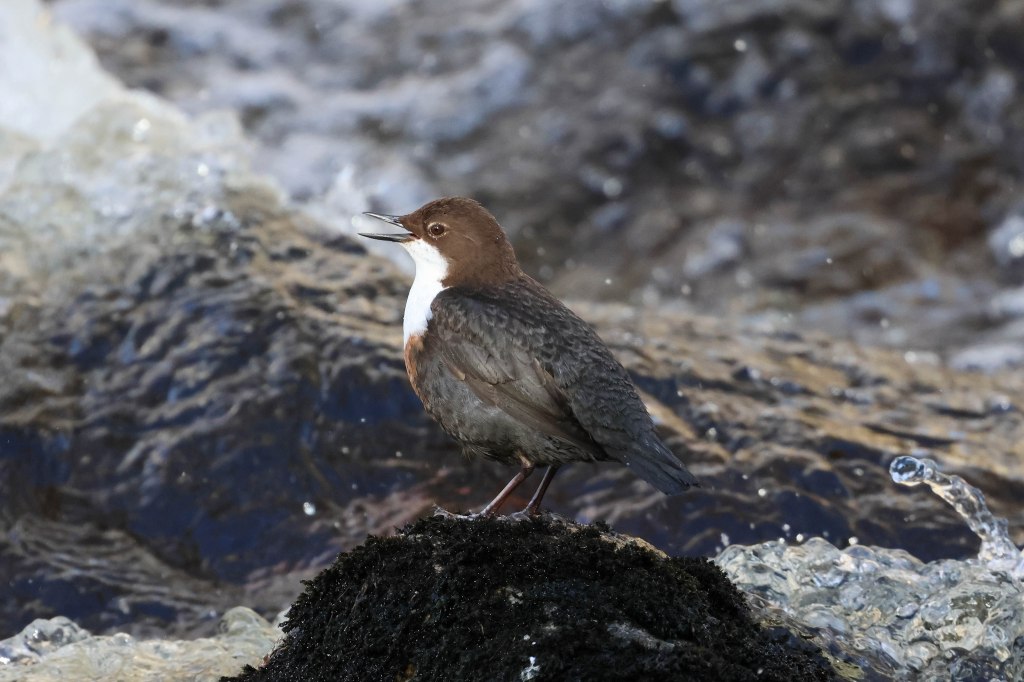
Eventually the Dipper did fly back down stream behind us, so we walked on upstream and then cut back through the trees towards the road. There were more birds coming and going from the feeder in the gardens from here. We took a track into the woods, where there were several more feeders up. Again, we found lots of Coal Tits and a few Great Tits, Blue Tits and Chaffinches, but no sign of the hoped for Crested Tit. We walked on into the wood, but it was increasingly quiet away from the feeders so we decided to turn back.
We decided to try our luck at another wood nearby. As we walked up the hillside through the trees, we could hear Long-tailed Tits calling and a Red Kite appeared above the tops overhead. It was mid afternoon, and rather quiet now. We stopped to watch a Treecreeper scaling one of the pine trunks, then followed it down a side turning. We didn’t get too far before we came to a fence, so had to turn back. It was fortuitous we did, as back at the junction we heard Crossbills calling quietly high in the pines above us now.
We tried to locate them and as we shifted position three Crossbills flew out of the pines above us, two disappearing off deeper into the trees but a male landed high in one of the pine by the path. We had a quick look at it before it flew again, back across the path and lower down the hillside. We walked down and realised where it was when a pine cone was dropped form the treetops. Eventually, we spotted two flitting around high in the tree and then the male appeared briefly on a branch high above us. When it flew again, further back, we could still hear calling, then it flew again and disappeared off over the trees.

The taxonomic position of Crossbills is very complicated, and debate continues to rage over where the birds in Scotland fall, given there are Common Crossbills, Parrot Crossbills and ‘Scottish’ Crossbills all present at times. The flight call of these birds sounded more like Parrot/’Scottish’ and less like the sharp ‘glipping’ flight call of most Common Crossbills, but while the male looked largish billed, but the bill did not look big enough for Parrot. ‘Scottish’ Crossbill would appear to be the closest fit, but there are no diagnostic features which can be used to identify ‘Scottish’ Crossbills now.
Back down to the minibus, we still had a little time to play with before we had to be back. There had been a drake Ring-necked Duck on Loch Vaa the last few days, so we drove round there to see if we could find it. It had been a lovely sunny day up to now, but we could see grey cloud approaching. We found the path behind the cemetery car park and walked up over the bank and down to the edge of the loch, Where we quickly located the Ring-necked Duck out in the middle with several Tufted Ducks. Smart.
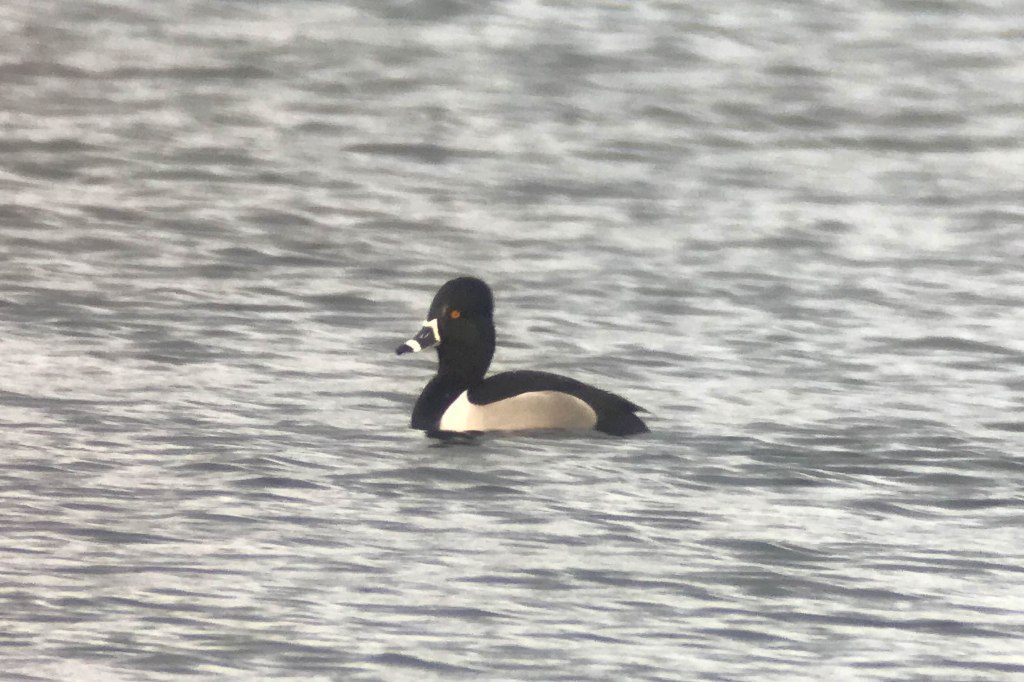
There were also four Goosander on here, two drakes and two redhead females. Two Little Grebes were laughing at us from the edge. It started to drizzle now, although thankfully not for long, but we decided it was time to head back in time for dinner.
Wednesday 22nd March
The weather forecast for today was not good, with a yellow wind warning in place and sleet showers expected, but we set out to make the best of it. We had a short pre-breakfast walk today – it was raining when we met outside but quickly cleared through on the wind which was already picking up. Down at the bridge, we heard a Dipper calling and looked downstream to see two together on a rock on the bend in the distance. They took off and flew straight towards us, the first continuing straight on underneath the bridge below us, while the other landed in the river briefly, then followed.
We walked across to the other side and looked across at the old bridge, to see both Dippers on the rocks here now. They were perched together, wing flicking, and then both disappeared into a cleft in the rock. We wondered whether they might be prospecting for a nest site, but when they came out again, one flew across the river and collected a bill full of nest material before they both flew off downstream again, and were lost to view round the bend.
A pair of Grey Wagtails appeared too, on the rocks below the old bridge, and both went to investigate the cleft in the rocks as well, before disappearing round the bend in the river. We set off along the riverside path, and could hear the male Grey Wagtail still singing below us.
There were lots of Greenfinches in the trees, still much commoner here than back home, and a few House Sparrows in the gardens. A Mistle Thrush was down on the grass in the paddocks and another was up on the wires beyond. Down from the wobbly bridge, a female Goosander was preening in the rocks on the corner of the river. We could see more dark clouds approaching from the west and the wind was starting to pick up, so we cut back along Station Road, pausing just to watch a Treecreeper in the birches across the road. We were almost back to the main road when it started to sleet, so heads down we hurried back to the warmth of the guest house for breakfast.
The sun came out over breakfast and we could see blue sky outside the window, but as we gathered outside after breakfast another sleet shower blew in. We were planning to have another walk in the woods first so we decided to drive down to Loch Mallachie and by the time we arrived, the skies had cleared once again. It was clearly going to be a stop start day with the showers, but we had only walked a short way into through woods when the sky went dark above the trees and the tops started to lash around in the wind. It looked like there might be a heavy shower coming, so we walked quickly back to the minibus, but it cleared through more quickly than we were expecting so we were able to resume our walk.
We had not gone far, when we heard Crossbills calling in the trees above us. They sounded more like Common Crossbills, but it was still windy and we couldn’t see where they were before they seemed to disappear back over the trees and it went quiet. There were a few Coal Tits and Chaffinches in the trees, more Siskins over, and we heard Crossbills over again further down, but otherwise it was fairly quiet in the trees this morning. No sign of our hoped for Crested Tits.

There were lots of Common Toads on the path as we got down towards the loch, but it was more open here and very windy. We had a quick scan over the water but could just see a single Goldeneye and a Mallard in the reeds at the back, so we continued on round the corner of the path and back into the shelter of the trees. As we walked back, there were several more Goldeneye in the more sheltered edge of Loch Garten. We got back to the minibus just in time as it started sleeting again.
Given the weather, we thought we would have another quick from the minibus to see if there were any tits back in the car park at Loch Garten while it was raining. There was even less activity than yesterday, but we put some seed out, and quickly the Chaffinches and Coal Tits came down to take advantage. A Treecreeper appeared in the trees behind again. When the rain started to ease, all the birds disappeared back into the trees so we decided to move on.
After a quick stop in Nethy Bridge again to use the facilities, we drove over to Strathdearn. At least the raptors might appreciaet the wind. It started to sleet as we drove up the A9, and continued heavily for quite a time to the point where we even started to wonder whether we might have to abandon the day, before thankfully it cleared through just as we got to the valley and the sun came out. The views were stunning now as we drove up the narrow, winding road. We could see some dots right on the top of the hillside opposite which turned out to be a herd of Red Deer.
We parked at the top of the valley and it was so windy at first we struggled to open the door on the exposed side of the minibus. We all got out in the lee of minibus (doors on both sides and a bench seat in the front a big advantage!) and scanned the surrounding hills from the shelter of the vehicle. Two Peregrines appeared along the ridge behind us, chasing each other.
We didn’t have to wait too long before a Golden Eagle appeared over the hills opposite, dropping down behind a ridge, then coming back up again, then disappearing from view once more. A Raven drifted over. Then the same or another Golden Eagle came up, drifting right across the valley to our side now and hanging in the air over the ridge back along the road. It started to come towards us, gaining a little height, and we thought it might eventually come right over our heads before a Peregrine powered up towards it from the cliffs below. A Common Buzzard was up too now, all three together in the same view. The Peregrine had a go at the Golden Eagle, diving at it a couple of times from above. The Eagle quickly decided to head back across valley.
The raptors were clearly enjoying the wind today, as we had hoped they would. There was a juvenile Peregrine along the ridge behind us pretty much throughout, playing in the wind and landing on the slope. We got it in the scope for a closer look a couple of times. Then two Merlins appeared, chasing around above the trees further up the valley, before towering up higher into the sky. We watched one gain a lot of height and then shoot off across valley before dropping down sharply behind the ridge the other side.

While we were enjoying all the raptor action, the wind had dropped a fraction. We had thought we might need to find somewhere more sheltered for lunch, but it was now nice enough we could stop and eat here, amid all the activity. Thankfully, we had finished eating and packed away before we could see the next bank of cloud coming over the head of the valley, so we decided to move on. We were lucky with the timing today!
We drove back down the valley as the rain blew in. There were still patches of sunshine and blue sky and some impressive rainbows, dropping down to the valley below. We thought there must be a pot of gold down there somewhere, but perhaps we had already seen our Golden Eagle gold! The Farr road is one of our favourites, bleak and open out on the high moors, stunning scenery and it was especially moody today. As we drove over the tops there was rain one side, and it even seemed like the cloud was below us and we were looking down on the weather, before we got to the blue sky and had some stunning views over the hills ahead as we dropped down the other side. The weather might be challenging but the views sure were special!
Back down to earth, we drove round to Loch Ruthven. A female Stonechat was on the fence as we got out of the minibus. It was nice enough now, but given the vagaries of the weather today we made our way quickly down along the path. We scanned the loch as we passed but couldn’t see anything on the water through the trees, although it was very choppy in the wind and there was a remarkable swell running across and there were some impressive waves breaking on the shore. We headed quickly to the shelter of hide.
Five Teal and a couple of Mallard were feeding in the sheltered corner in front of the hider and a female Goosander was dozing on a rock opposite, right over the far side. There were two Little Grebes over there too and a lone Cormorant appeared out in the middle. We sat in the hide and scanned round, but we couldn’t find any Slavonian Grebes from here, which was what we had come to try to find. Three Red Kites and two Common Buzzards were playing over the trees on the ridge on the far side, and a flock of Starlings occasionally whirled round, three Fieldfares with them.
Another squally shower blew in, so we closed the windows and hunkered down, before once again it cleared through as quickly as it had arrived. We decided to walk back now, and as we made our way along the path we scanned the loch through the trees again. There was a Slavonian Grebe now out on the water! In pretty much full summer plumage already, we hurried on to the small beach and got it in the scope. A nice view, ironically it then sailed out further down the loch to where we would have been able to see it from the hide. Still, it was a smart bird and it was mission accomplished!

Back at the car park, it was sunny again now. Scanning the surrounding hills, we could see six more Red Kites over the clearfell and hillside opposite. One or two Common Buzzards circled up too and a Raven appeared over a distant hillside and started tumbling. We stopped to watch for a few minutes.
Given the apocalyptic forecast this morning, we had not only managed to survive the day but actually had a remarkably productive one. We had a bit of a drive back, and then had a little bit of time to relax before another delicious three course dinner tonight.
Thursday 23rd March
Before breakfast, we drove over to Nethy Bridge to have another go for Crested Tit. They can always be tricky after the winter, when they stop coming to feeders and retreat into the forests where they spend more time in the tops of the trees, but at this time of year we are on the cusp. It was not a particularly warm start to the year too this year (unlike 2022) and we had hoped we might still find some coming to food. It was chilly and damp as we walked down through the trees at first, the morning light not yet coming through, and perhaps not surprising there was nothing actually on the feeders. We could hear a Great Spotted Woodpecker calling, and looked up to see it perched in the very top of a pine. Another two were drumming more distantly, one either side.
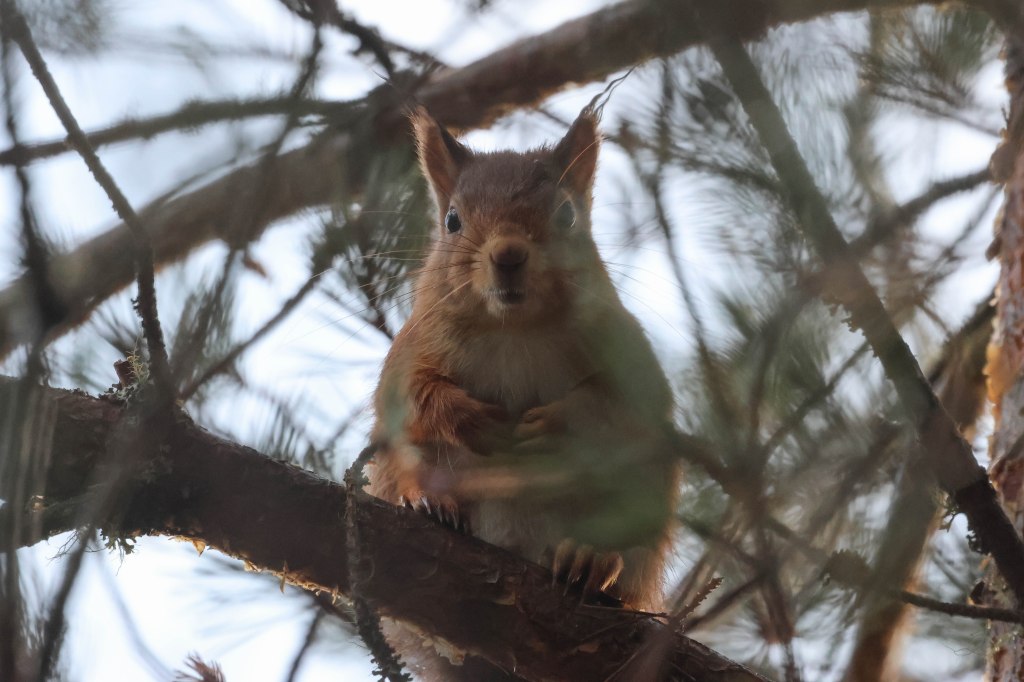
We walked on along the path, to where it was a bit more open and there was a bit more light making it in. A Red Squirrel ran across in front of us, perhaps surprisingly the first we had seen, and up into a small pine, climbing right up into the top. We stood underneath watching, and it decided to make a dash for it. It ran down the line of trees beside the path, hopping from branch to branch, tree to tree, occasionally stopping and staring down.
There was still very little activity, even out in the open, although there was an annoying cloud in front of the sun. We saw one or two Coal Tits, Chaffinches, and Siskin over, as usual. Finally the early sun started to break through, and the light was now catching the tops of the trees, so we walked back in to the thicker trees. A Crossbill flew over calling. Back at the feeders, there were several Coal Tits… and there was a Crested Tit too. It looked like it might fly off initially but thankfully it stayed and we watched it for a minute or two on the feeder. Then it flew up into the trees behind and called, before it disappeared up into the tops of the pines.

We waited for a few minutes to see whether the Crested Tit would come back in, but it didn’t. Then it was time to head back for breakfast. There were several Roe Deer in the fields. We looked over to the Cairngorms on our way back to Carrbridge and were surprised to be able to see the tops now for the first time. That wasn’t in the forecast! We stopped briefly to take some scenic photos, but food was calling.
Given the sunny morning, a change of plan so after breakfast we drove up to Cairngorm Base Station. There were several Chaffinches in the car park when we drove in, and by the time we had parked and got out they had been joined by a Snow Bunting on the wall. It dropped down onto the verge so we walked over for a closer look, just as another two Snow Buntings flew in and landed on the wall. Lovely close views. We had a quick look in the garden, but it was quiet, just a single Raven overhead and a few Meadow Pipits over the ski slope beyond.
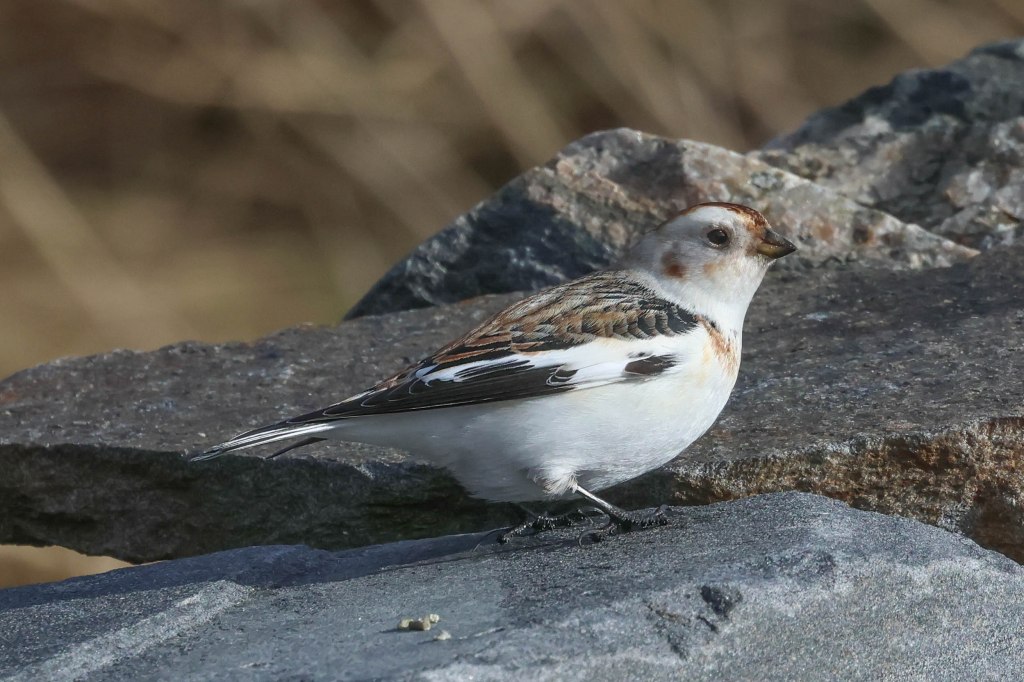

We had not thought we would be able to today, but the weather was so good we decided to have short walk up towards the Northern Corries. There had been fresh snow yesterday and overnight on the tops, but the lower slopes were still largely snow free. While it still looked very windy up on the top of the ridge (it had been gusting up to 109mph here yesterday!), it was more sheltered down here. We only had about an hour to play with, not long enough really to get high enough, but we walked for about half of that and then stopped to scan. There were lots of people out today, making the most of the sunshine, several groups of hikers heading up along all of the paths and we could see walkers already high on snowy ridges. Lots of disturbance. There was no sign of any movement on the slopes above us, apart from people. It was beautiful here though, and a great view.
Then we had to head back down to meet back up with a couple of the group who had stayed behind. We stopped for coffee down at the Base Station, and several of the group indulged in hot chocolate from the café, with marshmallows and topped with whipped cream. It was amazing to sit outside in the sunshine, with clear blue sky above – not what was forecast!
The plan was to head up to the Moray coast for the afternoon, so we had a long drive now up to Lossiemouth from here. We arrived in time for lunch, and ate on the edge of the harbour, looking out to sea. There were lots of Razorbills out on the water, some close in, some larger groups diving in unison. A few Common Scoter and Common Eider were further out and a couple of Gannets flew past. Two Sandwich Terns flew in over bay and past in front of us, our first of the year. We checked through all the gulls, but there was no sign of the Glaucous Gull around the harbour today. A succession of Typhoons came in low over town behind us, heading for RAF Lossiemouth, and a Peacock butterfly fluttered around the car park in the sunshine.
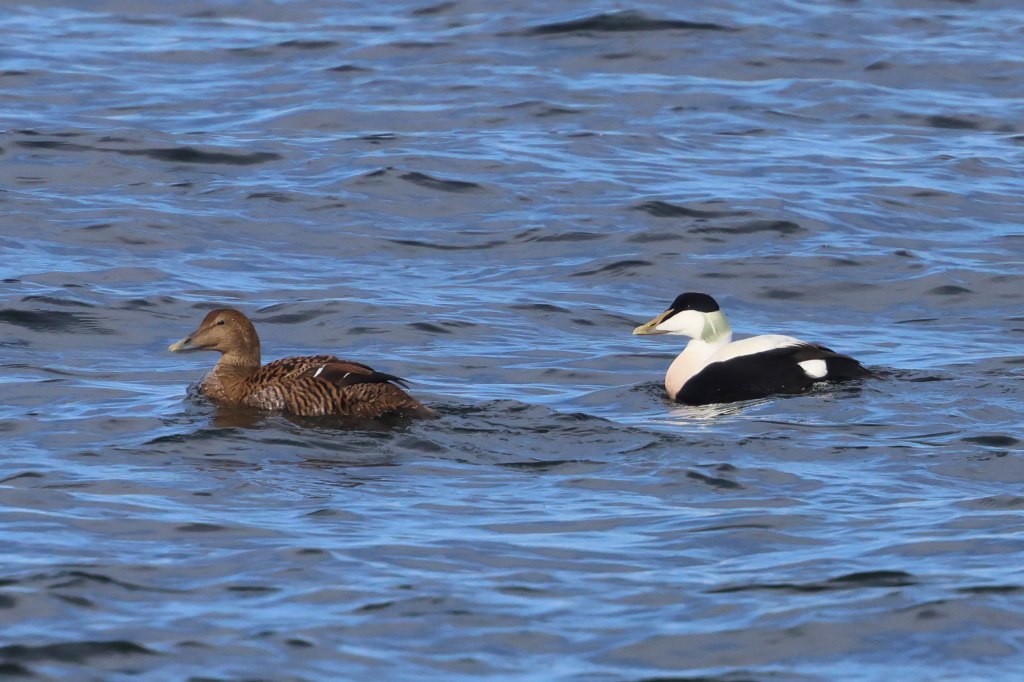
We could see lots of waders on the harbour wall distantly from here, mainly Purple Sandpipers. So after lunch, we walked round for a closer look. A Carrion x Hooded Crow hybrid was preening on the top of some crab pots, mostly black but with some grey patches. A female Eider was in the harbour between the boats and five more Eider were on the sea just off the end of the harbour wall, including several very smart drakes, so we got them in the scopes for a close up look. A summer plumaged Red-throated Diver was on the sea here too.
Down at the end of the harbour wall, we could just see some of the Purple Sandpipers on the edge above us. We climbed up the steps at the end and from the top could see an amazing number – we counted at least 120 Purple Sandpipers, together with a smaller number of Turnstones and a single Sanderling. They were mostly sleeping over high tide, but one or two were preening and occasionally there was a shuffle through the flock.
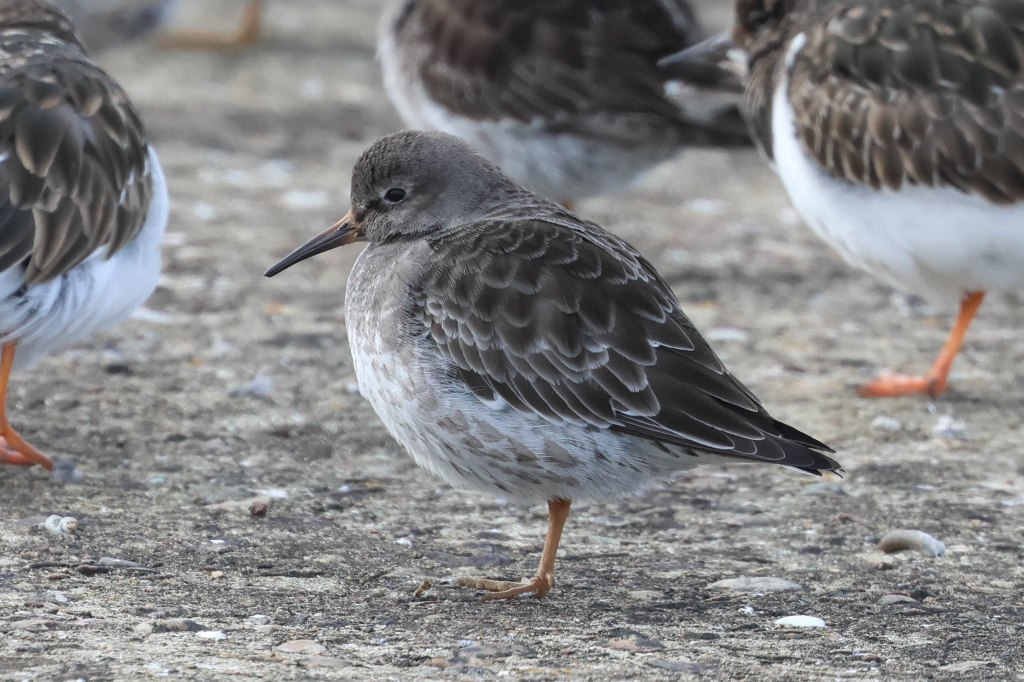
We scanned the sea and quickly found a Great Northern Diver offshore, an adult just starting to moult into breeding plumage, but there was no sign of any different gulls on the sea from here either. A large flock of Pink-footed Geese was circling over the fields distantly inland. The tide was already falling and as we came back down, the Purple Sandpipers were starting to head out to feed, flying right over the heads of those who had stayed down on the quay below. As we walked back round, a Rock Pipit was feeding on the stones just ahead of us.

We stopped to use the loos overlooking the estuary and could see lots of gulls now starting to gather on the falling tide. While people used the facilities, we scanned through, but again could find no sign of the Glaucous Gull, or the Iceland Gull which has been seen here later in the day recently. There were still more gulls dropping in, but we had other places we needed to visit so after a good look through we had to move on.
As we drove on west along the coast, a Merlin shot low over a field beside the road. We pulled up to check a large herd of swans in some winter wheat and were not surprised to find they were 30 Whooper Swans. Surprisingly, our first Linnet of the trip was perched in a bush by the road too.
We parked in the car park at Findhorn and walked up through the dunes to the beach. It was beautiful here looking out across the Moray Firth in the sunshine, but it was flat calm this afternoon so most of the birds were very distant. There were good numbers of auks again, and we managed to find one Guillemot closer in as well as more Razorbills. The only ducks we could pick out were some very distant Common Scoter off here today, and we managed to find a lone drake Red-breasted Merganser some way off to our right, which then flew past in front of us, low over the breakers. A Harbour Porpoise broke the surface once briefly.

There were lots of gulls feeding in the river mouth, but despite checking through we couldn’t see anything obviously different with them. There were lots of seals on the beach beyond the river, a mixture of Common & Grey Seals. Several Carrion x Hooded Crow hybrids were on the beach, sporting different amounts of grey, and one pure-looking Hooded Crow flew past in front of us, heading down to the river mouth.
On our way back, we had time for a quick stop in at Easter Dalziel to see if we could find the Green-winged Teal that has been lingering here. It had been here for over a week, although not reported for the last three days, but it hadn’t been reported daily during its stay anyway so we figured it could still be here. We took the small road down towards the site and found it had recently been closed off at the railway and there was no way through. At least 15 Yellowhammers were perched in the bushes at the back of the next door cattle field as we turned round.
We managed to find a way round, and located the flood where the grid reference indicted, but there was not much water here and only two Mallard. We turned down a side road to head back and found the next field down also had a flood, larger and better looking. There were lots of Teal on here, so we thought our luck might be in, but as we scanned with the scope we found they were all just Eurasian Teal. We had to head back now, to get back in time for dinner. A little further on a large flock of Pink-footed Geese were feeding in a wheat field next to the road.
It was just a short drive back down the A9 to Carrbridge, back to the guest house. It was a Scottish themed dinner tonight – haggis and neeps to start, followed by salmon. Aurora activity was high tonight so after 9pm a few of the group went out to check. There was a bit of patchy cloud but there was a striking glow in the sky behind. A little bit of green and maybe pink was just about visible with the naked eye, but it looked distinctly more impressive with a long exposure image from a camera which really brings out the colours.
Friday 24th March
It was forecast to rain this morning, so we didn’t go out for an early walk. After breakfast, we set off on the long drive up to Fraserburgh. It was raining most of the way but stopped as we got into Aberdeenshire and then started to brighten up as we approached the coast. Coming out of Banff, we could see swans over the ridge ahead and we drove underneath about thirty Whooper Swans as they headed out over the sea.
We parked by the lighthouse and got out to scan the sea. The Ross’s Gull had been seen late morning/early afternoon the last couple of days, so we had timed our visit to be around at that time, and it had already been reported flying past again much earlier today. There was no sign of it out over the sea when we arrived, just a steady stream of Kittiwakes moving, so we stood and continued to scan. It does only seem to appear sporadically, often just once a day.

There were lots of things to watch while we waited. There was a constant trickle of Gannets passing by, including some nice close ones right over the end of Kinnaird Head. There were lots of auks too, Razorbills and Guillemots, on the sea and flying past, and a large number of Shags. A few Fulmar skimmed low over the sea offshore too and a couple of Harbour Porpoise broke the surface briefly.
There were other birds moving offshore, these heading north on migration, particularly more Whooper Swans. After the ones at Banff earlier, we now had two more groups flying north out over the sea – twenty-eight and around forty. We also picked up five Skylarks flying north way out to sea and a Curlew too. It was a lovely place to sit and watch but we couldn’t wait all day. Our patience was rewarded a Puffin out on the water which was then joined by a second. It was already lunchtime but the decision was made to move on for lunch, so we drove west to Portsoy and down to the harbour.

We ate lunch looking out over the sea from the dolphin statue, a lovely spot to stand particularly on a sunny afternoon. No White-billed Divers had been reported off the coast here yet this year, but we figured someone had to be the first and around Portsoy is often the main area to find them. We had a good scan while we ate but all we could see today were three very distant Great Northern Divers away to the west. Six smart Long-tailed Ducks were on the water closer in plus a couple of Eider and more auks.
We decided to try Cullen next. As we got out on the clifftop, a male Yellowhammer was singing in the bushes. Scanning the sea, we could see lots more divers. We eventually counted at least twenty-four Great Northern Divers, mostly rather distant, and three Red-throated Divers closer in, but we couldn’t find any other divers off here today. There were two or three Black Guillemots on the sea too, a nice addition to the trip list, but the biggest surprise was finding more Whooper Swans, this time swimming in a tight raft a couple of miles out to sea, presumably stopping to rest on their journey. They really were on the move in good numbers today.

We had time for one last stop at Lossiemouth. We were too early for the white-winged gulls when we were there last time, as they only came back in the late afternoon yesterday. There were lots of gulls on the estuary now, but scanning from the toilet block end we couldn’t pick out anything in with them initially. There were a couple of Bar-tailed Godwits on the edge of the water opposite too, and two or three Grey Herons. It felt like our luck might be out today, particularly when news came through now that the first White-billed Diver of the spring had just been found only around 10 miles further along the coast. Unfortunately it was just too late for us to get there now, as we had to be back in Carrbridge in time for dinner. We had the right idea today, but we had just tried all the wrong places!
We just had time for a quick scan from the car park further down around the estuary and just as we had almost given up hope we picked up the adult Iceland Gull on the mud opposite. We could see its long, pure white wingtips and next to a Herring Gull it was noticeably slightly smaller. A nice late consolation prize.

We drove back inland and could see dark clouds ahead of us before we drove into heavy rain. It was very gloomy and wet across the moors We arrived back at the guest house with just enough time for a short break before our last dinner in Carrbridge – curry night!
Saturday 25th March
We were packing before breakfast, so there was no time for an early walk today. After breakfast, we said our goodbyes to Christine at the guesthouse and set off on our way back south. We arrived at Loch of the Lowes just as it had opened, perfect timing, but got out to the hide to discover that the pair of Ospreys had both just flown off. Thankfully, after only a short wait, the female Osprey flew back in to the nest and we had a great view through the scopes. We could see her shuffling, and on the pictures from the CCTV camera could see she was rearranging the nest.

The Osprey flew again, dropping down behind the trees, but was back just a few minutes later and landed on the post now, above the CCTV camera. She perched there for some time, preening, then looking around and up to the skies, possibly looking for the male. For the first time, both the Ospreys had returned here on the same day this year, on 17th March, the female first and the male around 6 hours later, the earliest date the female has returned (the male was back on 13th last year). We had received regular updates from several other nest sites during our stay in Carrbridge, but strangely none of the other nest sites we had thought we might visit were occupied before we left.
We scanned the loch, but all we could see today were a few Goldeneye, Tufted Ducks, Teal, Mallard and Canada Geese, several Great Crested Grebe and a single Little Grebe, and lots of Black-headed Gulls. A few Sand Martins above the trees just beyond the Osprey nest, and a couple of times a much larger flock came up, presumably feeding over the loch just beyond trees.
We stopped outside to watch the feeders. There were lots of tits coming and going, particularly Coal Tits, and lots of Chaffinches. A Nuthatch and a Great Spotted Woodpecker came in and out a couple of times. Some of the group had been in the hide watching the Osprey when the Nuthatch visited, and we could still hear it calling in the trees when they came out. It then took ages to reappear, although we did see a Red Squirrel hopping agilely through the trees while we waited. Finally the Nuthatch called and flew in to the peanuts, then up into a nearby oak and we watched as it hammered a nut into the bark.
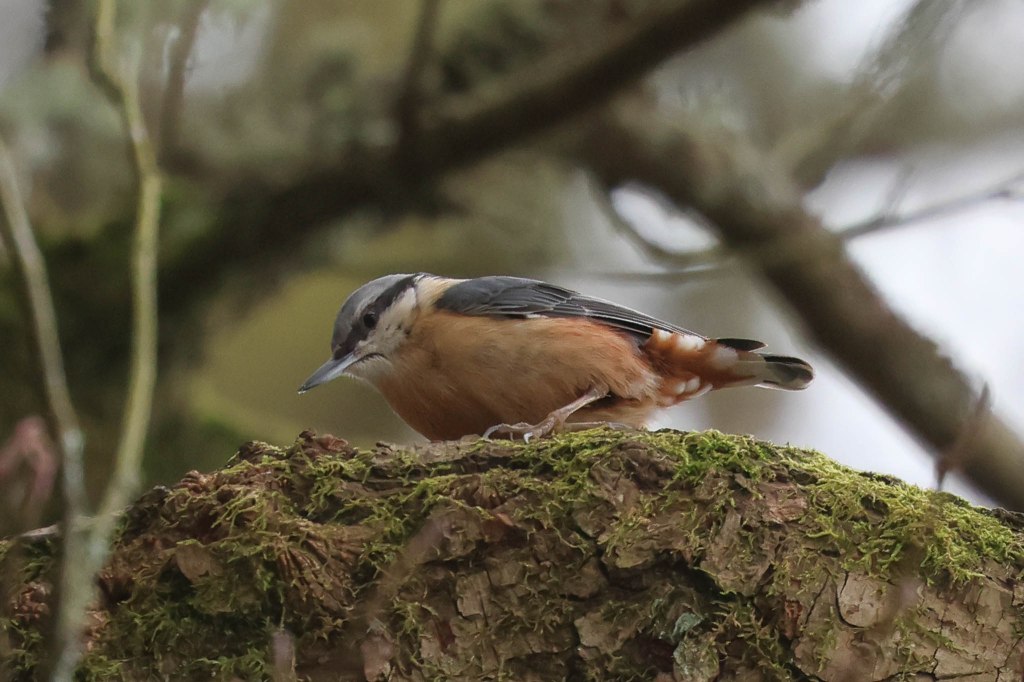
It was time to carry on south. We drove through drizzle on and off on the way down, but it brightened up by the time we got past Edinburgh and round to Dunbar. There had been three Alpine Swifts here for several days, only a very short distance off the A1, so we turned off and onto the access road down to Barns Ness to see if we could see them. Several cars were pulled up on the verge so we stopped and got out. We quickly located the Alpine Swifts over the trees, hawking low over the tops, back and forth. We had nice views in the scope of their white bellies and throats as they twisted and turned.
A major invasion of Alpine Swifts had taken place while we were up in Scotland, with birds overshooting on their way back north from Africa to Europe. We had missed the one at Bamburgh on our way up, so it was nice to get in on some of the action on our way back.
After watching the Alpine Swifts for a while, we continued down to the beach car park for a late lunch. There were still birds to see while we ate – a few Eider on the sea, two Red-breasted Merganser offshore, Gannets and Kittiwakes passing. Two Linnets landed on top of a gorse bush nearby. Afterwards, as we drove back to the entrance to the car park to use the loos, two Stonechats were on the fence. We could see one of the Alpine Swifts right over the road now, back where we had been standing earlier, but by the time everyone had finished using the facilities and we drove back, it had disappeared. There were only two Alpine Swifts now, still out over the trees and just a bit too distant for photos still.
We set off on our way south again. We were heading for Darlington, but we realised we still had time for one last stop on the way, if everything went to plan. The regular wintering Black Scoter in Northumberland has been elusive and difficult to see this year. After no reports for almost a month, it had been seen again two days ago at Cocklawburn and then at Stag Rocks yesterday, where it was still present this morning. Another message had come out while we were having lunch that it was till there and with the suggestion it was apparently ‘showing well’ now. The site is only a few miles off the A1, so we figured we would have a go.
We parked in the car park and walked up to the clifftop to scan the sea. A couple of Common Scoter and Long-tailed Ducks were out on the water. Someone then kindly drove up and wound down their window to tell us that the Black Scoter was still on the sea with three Common Scoter, further up, off the lighthouse, but had drifted a little north. We had a very quick walk up to make sure we got onto it before it drifted too far and became difficult to refind, but we needn’t have worried – it was still just offshore from the lighthouse.

We have seen it several times further north off Goswick in previous winters, and the Black Scoter can often be very distant, out on the sea. But it was amazingly close now, and we had great views in the scope of its bulbous yellow bill, a perfect comparison with two drake Common Scoter in the same group with just a yellow stripe down the front of their bills, the difference very clear now. From down on the rocks below the lighthouse, it was even closer – and the yellow top of the bill stood out even through binoculars in the late afternoon sunshine. Closely related to Common Scoter, Black Scoter is a very rare visitor to the UK being more usually found in North America or NE Siberia. While the driver ran back to the car park to get the minibus, one of the group found some Purple Sandpipers on the rocks here too.
We had been lucky with the weather again today. Continuing on down to Darlington, we drove into more rain. We arrived just as it was getting dark, and had time for a quick break before we met up for our last dinner together to reminisce about the trip and say our goodbyes.





















